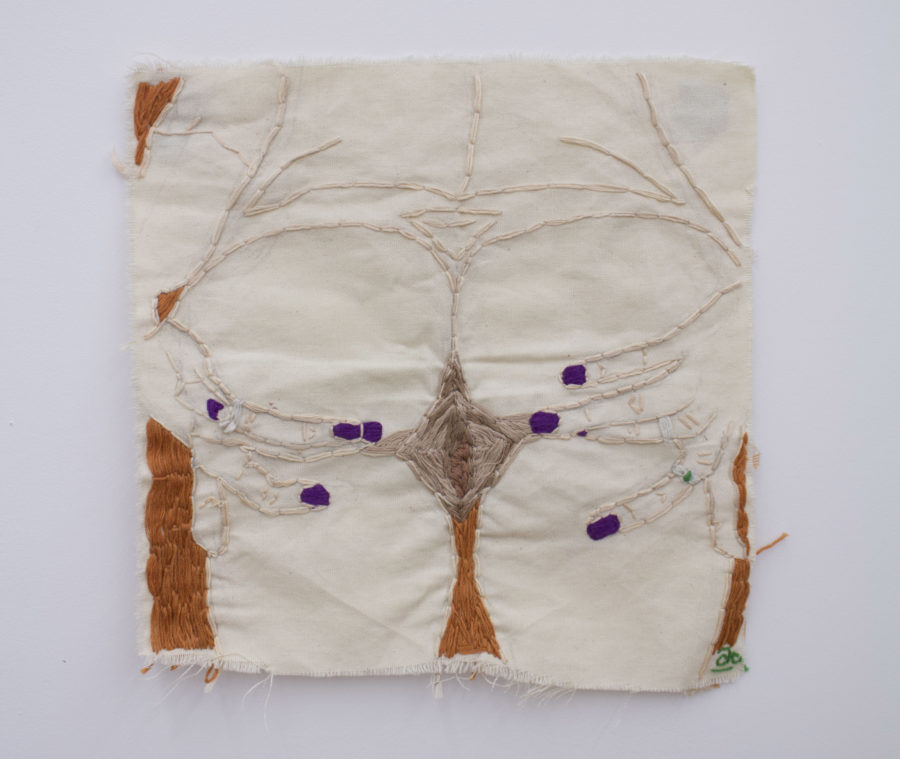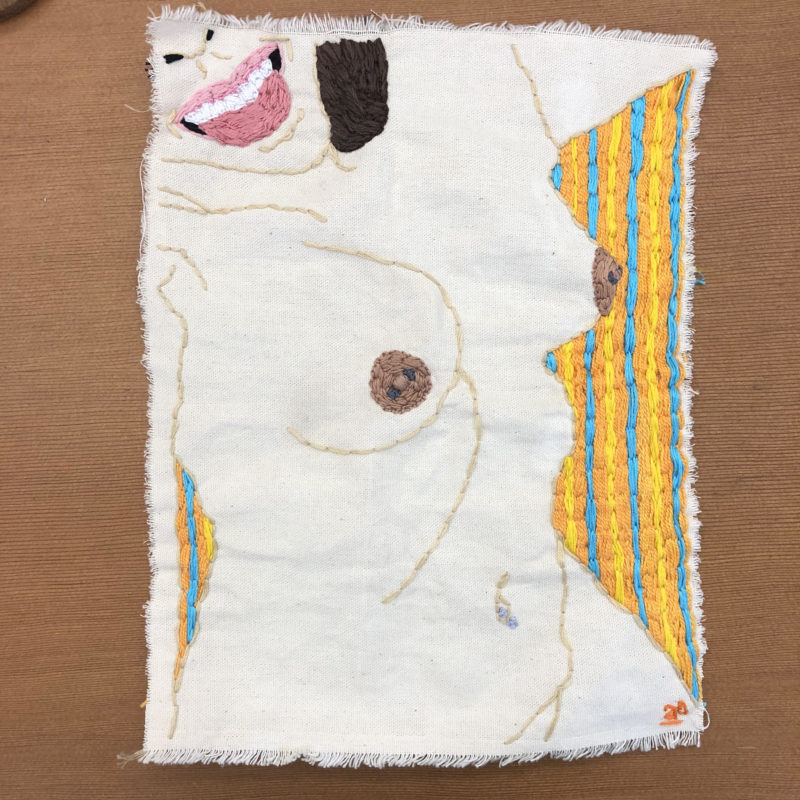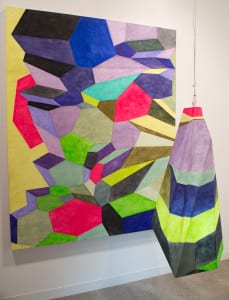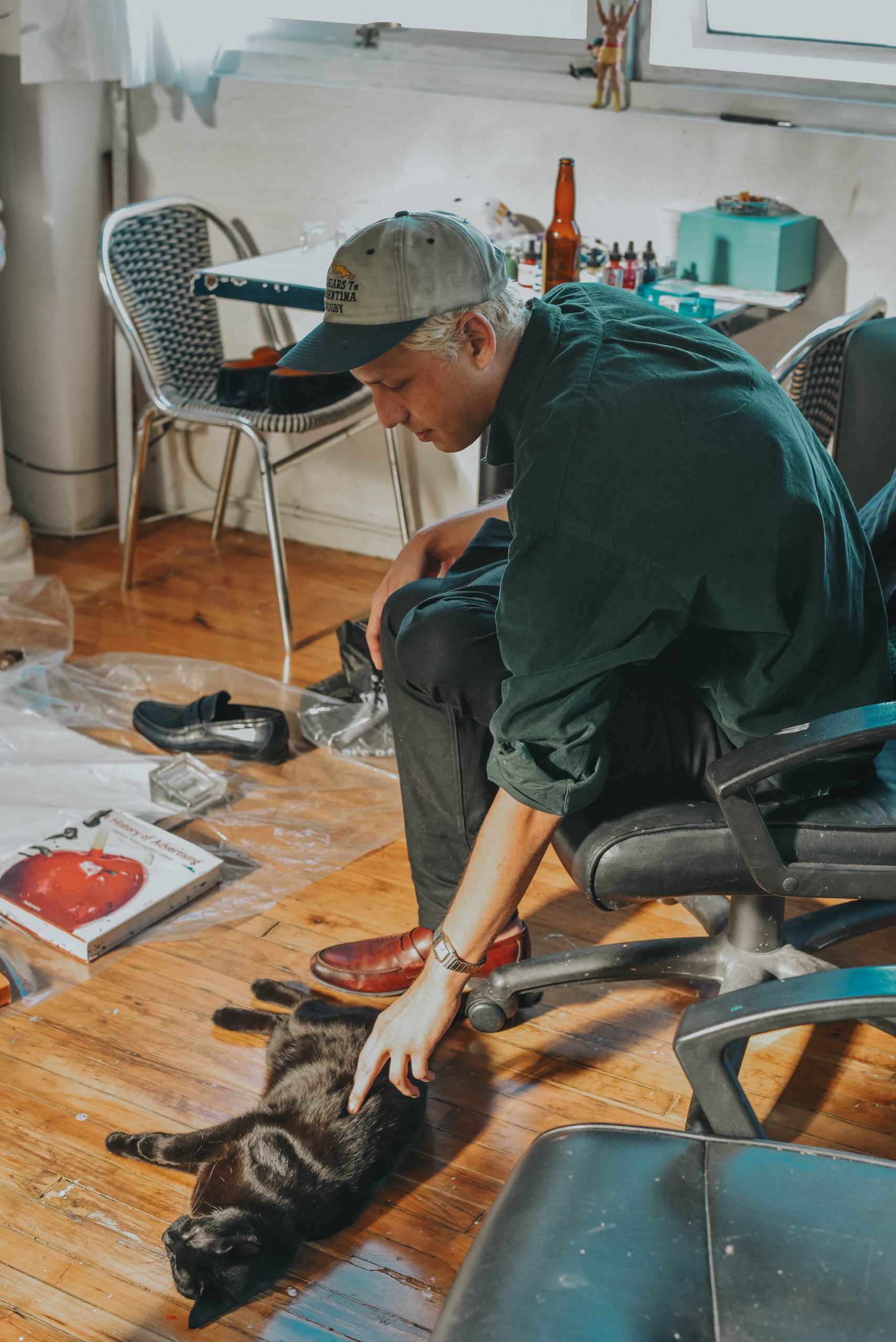This month for our #ArtPowerWomen series, we sat down with Alexandria Deters, an American artist whose intimate portraits explore body positivity and consent. It’s hard not to see why we were so drawn to Deters’ beautiful embroidery and portraiture.
#ArtWomenSeries is a pro bono collaboration with Curatious and GirlSeesArt that highlights talented unrepresented women artists. We turned to our collaborators Holly Hager, art collector and Founder of Curatious and Beckie Warren of GirlSeesArt to give their perspectives for this interview.
We all caught up with Deters to discuss her embroidery, sexuality, and the role of consent. This interview has been edited for length and clarity.
Art Zealous: Hometown?
Alexandria Deters: Born in San Jose, but consider Huntington Beach, CA my hometown.
AZ: Zodiac sign?
AD: Taurus
AZ: You have a BA in Art History and Women and Gender Studies, how has it affected your view of the world and your art practice?
AD: It has affected my work in many ways. I originally in undergrad was Studio Art/Art History major and because of that I took textile classes because I always wanted to learn how to embroidery and work with fabric. Through that, I gained the skills to make work in a medium that I have always admired, embroidery. Having my BA in Art History helped me learn a little bit about the history of embroidery and textile art, which has been historically seen as feminine. Being a highly feminine person, I was drawn to this medium and I’m proud to be part of its ongoing legacy. It has helped me analyze the history of embroidery differently and how to challenge it. Because of the explicit nature of my work, I want to make sure that they are seen as art and beautiful, not as something ‘dirty’ or for someone to ‘get-off’ on. With that in mind, I take time in making sure that the person looks just as beautiful as how I see them so that the subject sees that as well.

BW: You mentioned you are an only child who grew up being the center of attention and being photographed frequently. It is interesting that you are now using self-taken photos of your subjects as the primary inspiration for your work. Is that in any way an attempt to take back the control of who is being photographed and when?
AD: What a good question! I never thought about it at first, but I believe in a way it is. By having my subjects take their own photos, I know I am embroidering an image that they are comfortable with. Rather than someone else taking a candid photo or even hiring someone to take their photo, my subjects have complete control on the setting, pose, and angle, which I find very important with the type of explicit images I am embroidering.
KA: Is there something intrinsically satisfying about using embroidery as a medium?
AD: Most definitely! I am a tactile person, and I love being able to feel the thread and the different stitches that I use. I love seeing how a piece of fabric changes and evolves while stitching and feeling how the body of the fabric of the changes on the front and the back with my embroidery.
BW: What role does the concept of ‘consent’ play in your work and your life?
AD: It plays such a huge role. While I am a very sexual person, I have not been sexual with many people, and that is because I need to feel safe in a place and with a person. I have been in situations in my life that have been uncomfortable, but thankfully with all of my partners and ‘hook-ups’ whenever I said NO or STOP, they always stopped because they understand consent. In the world we live in, I believe consent and boundaries are very important for the safety of yourself and others, for mental and physical health.
My project is rooted in consent. When looking for new submissions, I make a post on my personal Instagram asking people to DM if they are interested in being part of my series. I explicitly state that if you want to submit DO NOT just send me a nude, first ask me, “Hey I would like to be a part of your series, could I submit some images to you?” From there, I will message saying yes or no, then explain how the submission process works. If they are comfortable with that, they are then permitted to submit images. The whole process for a piece starts with my asking, the person asking, and then re-confirming the person agrees. Each step has to do with consent.

HH + BW: Your work is extremely sex-positive. What role does sexuality and openness play in your work and your life?
AD: A very large role. As stated before, I am very sexual and drawn to sexual and erotic art. In my early twenties, I was unable to have sex except for a handful of times, almost three years because of painful it was due to medical issues. I still admired sexuality and sexual art, but I was removed from it because I was unable to fully participate in the experience of being sexual myself. I told a few of my close friends about the issues I was dealing with, but I didn’t talk about it openly and instead started to feel almost like an outsider when it came to sex and sexuality.
It wasn’t until the summer of 2015 that I started to become sexual again. Once starting graduate school, I broke up with my long-term girlfriend and started dating again, which meant going on dates, wanting to feel sexy, and looking at others in a sexual way. It was almost like a sexual reawakening. I was able to enjoy my sexuality and wanted to share it potentially with someone else. Once I met my current boyfriend who understood my history, past trauma, etc. I was able to fully bloom and became hypersexual. I am so open with him about what I want and how I feel. I love sending him sexy images throughout the day randomly because I like being sexy for him and most importantly myself. It was through me being so comfortable with him that I eventually started my series. One day I didn’t know what to embroider, and I was looking through my messages with him and saw one of the nudes I sent him. I thought I looked cute and the angle didn’t look too difficult, so I thought “Why not embroidery one the many intimate photos that I send him?”
Through doing that, I was able to focus on my body in a completely different way. I was able to admire my body and sexuality in a new and exciting way by focusing on it so intensely through embroidering. I shared the artwork on my personal Instagram. I received such amazing feedback and it made me think maybe I should embroidery more of these “nudes” and have others participate. When I was invited to be part of a group exhibition at 383 Gallery, I finally had to the opportunity to test out this idea for a series and it was shocking to me how much people liked it and enjoyed my pieces.
I believe it is through my openness and embracing of my own sexuality that have been people want to participate in my series and why so many people can relate to it and enjoy it.
HH: Your current series, Send N00dz, is especially interesting in the #MeToo era, because a “nude” is generally associated with the objectification of the subject. How do you address objectification in your nudes?
AD: By eliminating an outside person take the image, I am allowing the subject to have complete agency and control of their image. This is important because once I have the image, I might crop them in a way to best to suit being embroidered and on the size of the fabric I am embroidering on. I want the person to see the work I make of them and be happy and proud of how they look, by my doing that, I don’t let there be “male gaze” or even “female gaze” interfere by having myself or a photographer take my subjects’ photos. They are taking back that gaze and instead of being objectified, they are admired and appreciate their image and body.
BW: There seems to be an intimate connection and a high level of trust between you and your subjects. Are they all close friends or people you know? If yes, would you consider opening the project up to outsiders who admire your work and your message?
AD: As of now, all of my subjects have been myself, close friends, and people that I know. I have thought about opening up my project to others, but at the moment I’m holding off. I feel that I need to be comfortable enough with the person to embroidery their nude or partially nude body. I also send my subjects updates while I am working on their image, which I feel is important. I do not think I would feel as comfortable sending constant updates on a work if I do not know the person. I feel it might allow for that person to critique what I am doing or ask me to change my process. I also worry that if I open up to anyone I will receive unsolicited images, (which has already happened), which makes me very uncomfortable. However, if the right person were to come along and ask I would consider including them in the series.

BW: You are very active on social media. What role, if any, does social media play in the way you perceive beauty in yourself and others, and what you consider to be a ‘beautiful’ body?
AD: A huge role for sure! Being able to see yourself, your peers, and people that you admire or ‘follow’ makes a person judge themselves constantly and compare themselves to others. I think it can warp our ideas of what we consider “beautiful” and “sexy,” especially with ourselves.
Having to learn how to navigate that while in recovery with my eating disorder has been a challenge, especially on what I consider beautiful with my own body. However, having access to so many different versions of beauty and beautiful bodies has only strengthened my own belief that all bodies are beautiful, no matter what shape, size, scars, etc. For me, beauty comes from within, rather than the ideas around sexy. So to answer your question, I do not have a specific definition for a beautiful body, rather any person that I care about or happens to be my subject in my works is what I consider a “beautiful” body.
BW: The modern-day “selfie” has an inherently fleeting nature. Often ‘nudes’ are sent via snapchat, where they disappear in seconds. Your work adds an element of permanence and importance to the selfie, as you painstakingly recreate the image using a needle and thread. What is it about the selfie that is intriguing to you?
AD: It intrigues me because it is unique and very much of this generation. Most of the time, it is taken quickly with not much preparation. It is quick, and while it might be shared on social media or with family and friends, it is not an image someone will print out or frame. It is not considered ‘fine art’ or even ‘art’ in the traditional sense.
With that in mind, I find it exciting to take a nude ‘selfie,’ that may or may not have been shared and examine the image, the person, and the person’s body as it looked at the particular moment in time, when they felt confident and sexy. Then by taking the time to focus on this type of ‘selfie’ and recreating it in the painstaking and time consuming medium of embroidery, I am memorializing and elevating it fine art and I find that fantastic.
AZ: What do you have coming up next?
AD: Continuing to work on my series and making my new apartment a home.
To be considered for the series, post your work with #artpowerwomen.
top image // photo courtesy of Olivia Locher



